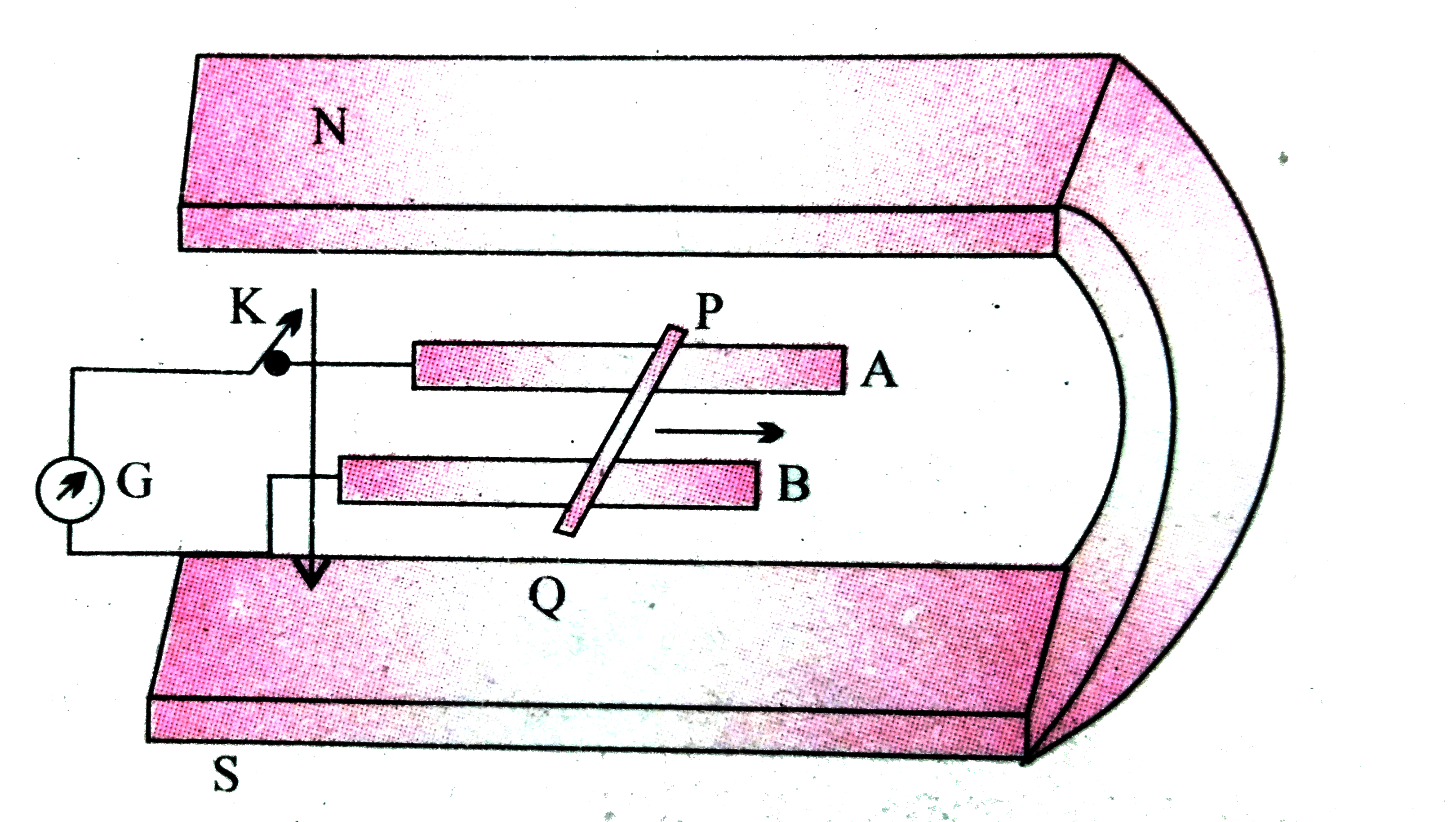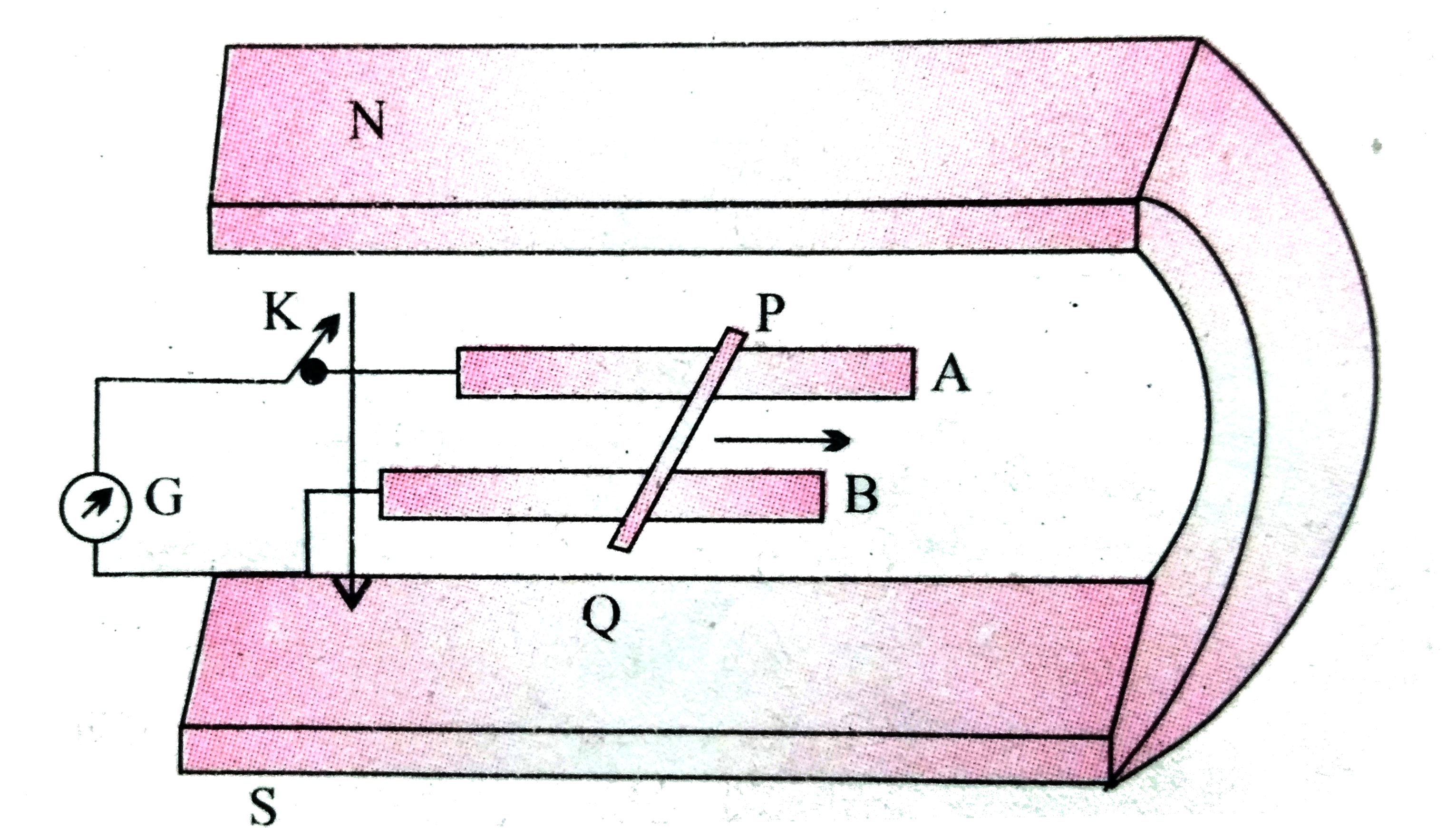The figure given below shows a metal rod PQ resting on the smooth rails AB and positioned between the poles of a permanent magnet. The rails, the rod and the magnetic field are in three mutual perpendicular directions. A galvanometer G connects the rails through a switch K. Length of the rod = 15 cm, B = 0.50 T, resistance of the closed loop containing the rod = 9.0 m Ω. Assume the field to be uniform.
 (a) Suppose K is open and the rod is moved with a speed of 12cms−1 in the direction shown. Give the polarity and magnitude of the induced emf.
(a) Suppose K is open and the rod is moved with a speed of 12cms−1 in the direction shown. Give the polarity and magnitude of the induced emf.
(b) Is there an excess charge built up at the end of the rods when K is open? What if K is closed?
(c) With K open and the rod moving uniformly, there is no net force on the electrons in the rod PQ even though they do experience magnetic force due to the motion of the rod. Explain.
(d) What is the retarding force on the rod when K is closed?
(e) How much power is required (by an external agent) to keep the rod moving at the same speed (= 12 cm s^(-1)) when K is closed? How much power is required when K is open?
(f) How much power is dissipated as heat in the closed circuit? What is the source of this power?
(g) What is the induced emf in the moving rod if the magnetic field is parallel to the rails instead of being perpendicular?
Given, length of rod, l = 15 cm = 0.15 m
Magnetic field of permanent magnet, B = 0.50 T,
Velocity of rod, v=12cms−1=12×10−2ms−1
Magnitude of emf induced will be
|ε|=vBl=0.12×0.50×0.15=9.0mV=9×10−3V
Using Fleming.s right-hand rule, P is the positive end and Q is the negative end.
(b) Yes, it is developed due to induced emf across the ends of the rod. When K is closed, the excess charge is maintained by the continuous flow of current (as long as rod is moving)
(c) Magnetic force acting on the electrons due to motion of the rod in the magnetic field is cancelled by the electric force set up due to the excess charge of opposite signs at the ends of the rod.
(d) When the key K is closed, current flows through the closed loop.
Current induced in the closed loop containing the rod is
I=εR=9×10−39×10−3=1A
Retarding force on the rod is
F=IBl=1×0.15×0.5=75×10−3N
(e) Power required by an external agent against the above retarding force to keep the rod moving uniformly at 12cms−1 is:
P=F×v=75×10−3×12×10−2
=9.0×10−3W
In case of open circuit no power will be required to maintain the velocity of rod because no current will be flowing.
(f) Power dissipated as heat due to induced current flowing through the circuit containing resistance R is
P=I2R=(1)2×9×10−3=9.0×10−3W
The source of this power is the power provided by the external agent as calculated in part (e).
(g) When field becomes parallel to rails, moving rod does not cut field flux lines. As there is no change in magnetic flux, induced emf becomes zero.
Topper's Solved these Questions
- ELECTROMAGNETIC INDUCTIONBOOK - MODERN PUBLICATIONCHAPTER - ELECTROMAGNETIC INDUCTIONEXERCISE - NCERT FILE (NCERT EXEMPLAR PROBLEMS SUBJECTIVE QUESTIONS) (Very short answer type questions)
6 Videos
- ELECTROMAGNETIC INDUCTIONBOOK - MODERN PUBLICATIONCHAPTER - ELECTROMAGNETIC INDUCTIONEXERCISE - NCERT FILE (NCERT EXEMPLAR PROBLEMS SUBJECTIVE QUESTIONS) (Short answer type questions)
5 Videos
- ELECTROMAGNETIC INDUCTIONBOOK - MODERN PUBLICATIONCHAPTER - ELECTROMAGNETIC INDUCTIONEXERCISE - NCERT FILE (NCERT TEXTBOOK EXERCISE)
10 Videos
- ELECTRIC CHARGES AND FIELDS BOOK - MODERN PUBLICATIONCHAPTER - ELECTRIC CHARGES AND FIELDS EXERCISE - Chapter Practice Test
15 Videos
- ELECTROMAGNETIC WAVESBOOK - MODERN PUBLICATIONCHAPTER - ELECTROMAGNETIC WAVESEXERCISE - CHAPTER PRACTICE TEST
14 Videos
Similar Questions
Consider a magnet surrounded by a wire with an on/off switch S (refer to figure). If the switch is thrown from the off position (open circuit) to the on position (closed circuit), will a current flow in the circuit?
Explain.

View SolutionA magnetic field in a certain region is given by B=B0cos(ωt)ˆk and a coil of radius a with resistance R is placed in the x-y plane with its centre at the origin in the magnetic field, Fig. Find the magnitude and the direction of the current at (a,0,0) att=π/2ω,t=π/ω and t=3π/2ω.

View SolutionPredict the direction of induced current in the situations described by the following Figures (a) to (f):


View SolutionWhy electrostatic field is normal to the surface at every point of a charged isolated conductor?
View SolutionCan a displacement current produce a magnetic field as the conduction current does ?
View SolutionFollowing figure shows a metal rod PQ resting on the smooth ralls AH and positioned between the poles of a permanent magnet. The rails, the rod and the magnetic field are in three mutual perpendicular directions. A galvanometer G connects the rails through a switch K. Length of the rod 15 cm, B 0.50 T, resistance of the closed loop containing the rod 9.0 mOmega . Assume the field to be uniform. Suppose K is open and the rod is moved with a speed of 12"cm s"^(-1) in the direction shown. Give the polarity and magnitude of the induced emf.
View SolutionFollowing figure shows a metal rod PQ resting on the smooth ralls AH and positioned between the poles of a permanent magnet. The rails, the rod and the magnetic field are in three mutual perpendicular directions. A galvanometer G connects the rails through a switch K. Length of the rod 15 cm, B 0.50 T, resistance of the closed loop containing the rod 9.0mΩ. Assume the field to be uniform.
Is there an excess charge built up at the ends of the rods when K is open? What if K is closed?
View SolutionFollowing figure shows a metal rod PQ resting on the smooth ralls AH and positioned between the poles of a permanent magnet. The rails, the rod and the magnetic field are in three mutual perpendicular directions. A galvanometer G connects the rails through a switch K. Length of the rod 15 cm, B 0.50 T, resistance of the closed loop containing the rod 9.0 mOmega . Assume the field to be uniform. With K open and the rod moving uniformly, there is no net force on the electrons in the rod PQ even though they do experience magnetic force due to the motion of the rod. Explain.
View SolutionFollowing figure shows a metal rod PQ resting on the smooth ralls AH and positioned between the poles of a permanent magnet. The rails, the rod and the magnetic field are in three mutual perpendicular directions. A galvanometer G connects the rails through a switch K. Length of the rod 15 cm, B 0.50 T, resistance of the closed loop containing the rod 9.0 mOmega . Assume the field to be uniform. What is the retarding force on the rod when K is closed?
View SolutionFollowing figure shows a metal rod PQ resting on the smooth ralls AH and positioned between the poles of a permanent magnet. The rails, the rod and the magnetic field are in three mutual perpendicular directions. A galvanometer G connects the rails through a switch K. Length of the rod 15 cm, B 0.50 T, resistance of the closed loop containing the rod 9.0mΩ. Assume the field to be uniform.
How much power is required (by an external agent) to keep the rod moving at the same speed (=12 cm s−1) when K is closed ? How much power is required when K is open?
View SolutionFollowing figure shows a metal rod PQ resting on the smooth ralls AH and positioned between the poles of a permanent magnet. The rails, the rod and the magnetic field are in three mutual perpendicular directions. A galvanometer G connects the rails through a switch K. Length of the rod 15 cm, B 0.50 T, resistance of the closed loop containing the rod 9.0mΩ. Assume the field to be uniform.
How much power is dissipated as heat in the closed circuit ? What is source of this power?
View SolutionFollowing figure shows a metal rod PQ resting on the smooth ralls AH and positioned between the poles of a permanent magnet. The rails, the rod and the magnetic field are in three mutual perpendicular directions. A galvanometer G connects the rails through a switch K. Length of the rod 15 cm, B 0.50 T, resistance of the closed loop containing the rod 9.0mΩ. Assume the field to be uniform.
What is the induced emf in the moving rod if the magnetic field is parallel to the rails instead of being perpendicular?
View Solutionचित्र में एक धातु की छड़ PQ को दर्शाया गया है जो पटरियों AB पर रखी है तथा एक स्थायी चुम्बक के ध्रुवो के मध्य स्थित है । पटरियाँ , छड़ एवं चुंबकीय क्षेत्र परस्पर अभिलंबवत दिशाओ में है ।एक गैल्वेनोमीटर ( धारामापी ) G को पटरियों से एक स्विच K की सहायता से संयोजित किया गया है । छड़ की लम्बाई 15 सेमी , B = 0.50 T तथा पटरियों , छड़ धारामापी से बने बंद लूप का प्रतिरोध = 9.0mΩ है । क्षेत्र को एकसमान मान ले ।

क्या कुंजी K खुली होने पर छड़ के सिरों पर आवेश का आधिक्य हो जायेगा ? क्या होगा यदि कुंजी K बंद कर दी जाए ?
View Solutionचित्र में एक धातु की छड़ PQ को दर्शाया गया है जो पटरियों AB पर रखी है तथा एक स्थायी चुम्बक के ध्रुवो के मध्य स्थित है । पटरियाँ , छड़ एवं चुंबकीय क्षेत्र परस्पर अभिलंबवत दिशाओ में है ।एक गैल्वेनोमीटर ( धारामापी ) G को पटरियों से एक स्विच K की सहायता से संयोजित किया गया है । छड़ की लम्बाई 15 सेमी , B = 0.50 T तथा पटरियों , छड़ धारामापी से बने बंद लूप का प्रतिरोध = 9.0mΩ है । क्षेत्र को एकसमान मान ले ।

कुंजी बंद है तथा छड़ 12 सेमी /से की चाल से दर्शायी गयी दिशा में गतिमान होने की स्थिति में छड़ पर लगने वाले अवमंदन बल का मान क्या होगा ?
View SolutionA metal rod PQ is resting on the rails A'B' and positioned between the poles of a permanent magnet. The rails, the rod and the magnetic field are in three mutually perpendicular directions. A galvanometer G connects the rails through a switch K. Length of the rod = 15 cm, B = 0.50 T, resistance of the closed loop containing the rod = 9.0 mOmega . Assume the field to be uniform. Suppose K is open and the rod is moved with a speed of 12 cm. s^(-1) in the direction shown. Give the polarity and magnitude of the induced emf.
View SolutionA metal rod PQ is resting on the rails A'B' and positioned between the poles of a permanent magnet. The rails, the rod and the magnetic field are in three mutually perpendicular directions. A galvanometer G connects the rails through a switch K. Length of the rod = 15 cm, B = 0.50 T, resistance of the closed loop containing the rod = 9.0 mOmega . Assume the field to be uniform. Is there an excess charge built up at the ends of the rods when K is open? What if K is closed?
View Solution
